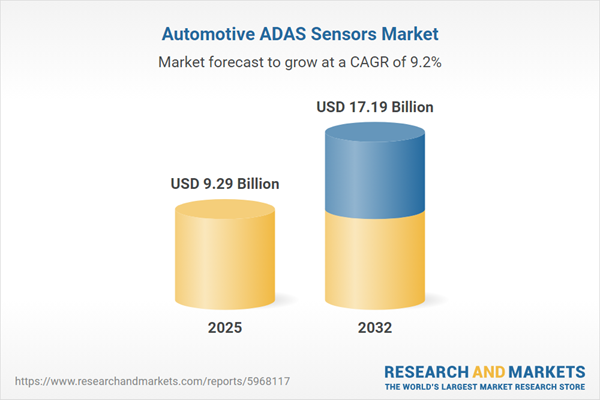Speak directly to the analyst to clarify any post sales queries you may have.
The automotive ADAS sensors market is undergoing transformation, presenting senior decision-makers with new challenges and strategic opportunities related to supplier coordination, technology integration, and regulatory adaptation. Successful navigation requires a focus on scalable solutions and resilient procurement in an increasingly dynamic environment.
Market Snapshot: Automotive ADAS Sensors Market Overview
The automotive ADAS sensors market reached a value of USD 8.52 billion in 2024, expanding with projections to USD 9.29 billion in 2025 and forecasted to USD 17.19 billion by 2032, reflecting a CAGR of 9.17%. This upward trend is fueled by continual investments in advanced vehicle safety and improved integration of innovative sensor technologies. Both established players and emerging companies are rethinking procurement strategies to accommodate evolving regulatory frameworks and global standards. In response, the market is seeing the formation of technology alliances, realignment of supply chain tactics, and a renewed focus on seamless technology deployment across automotive sectors. This landscape encourages participants to reimagine value delivery and strengthens the foundations for competitive differentiation.
Scope & Segmentation
- Vehicle Type: Segmentation covers both passenger cars and commercial vehicles, each presenting distinct demands for sensor integration. Passenger cars emphasize consumer-oriented safety features, while commercial vehicles focus on enterprise-grade reliability and fleet operational needs.
- Level of Autonomy: Solutions span from foundational driver assistance to advanced autonomous capabilities, enabling staged implementation to align with regulatory progression and regional mobility shifts.
- Sensor Type: The market includes a comprehensive mix, featuring single- and dual-camera setups, solid-state and mechanical lidar, various radar configurations, and ultrasonic sensors. This range supports compatibility with both legacy automotive platforms and emerging vehicle architectures.
- Application: Core use cases encompass adaptive cruise control, emergency braking, parking assistance, lane maintenance, and driver monitoring. These functions are critical for OEMs and fleet operators focused on enhancing vehicle safety and operational continuity.
- Geography: Regional analysis includes the Americas, Europe, Asia-Pacific, and the Middle East & Africa, highlighting unique regulatory priorities, innovation strategies, and supplier investment levels that impact sourcing and technology deployment.
- Key Companies Analyzed: Strategic assessments feature Robert Bosch GmbH, Continental Aktiengesellschaft, DENSO Corporation, Aptiv PLC, Valeo SA, ZF Friedrichshafen AG, Mobileye Global Inc., Magna International Inc., Hyundai Mobis Co., Ltd., and Forvia SA. These organizations are reviewed in the context of their technology alliances and their roles within evolving supply chains.
Key Takeaways: Strategic Drivers for Senior Decision-Makers
- Greater integration of perception systems and on-board computing enables the deployment of flexible, adaptable sensor solutions that reinforce supplier partnerships and innovative vehicle designs.
- Movement toward software-driven sensor fusion enhances customization options, helping organizations address diverse regulatory landscapes and evolving operational criteria without retrofitting core hardware.
- Facilitating collaboration across electronics, hardware, and software functions promotes agility and efficiency within procurement cycles and streamlines sensor rollouts, optimizing network resilience.
- Distinct technology strategies for passenger, commercial, and fleet vehicles allow companies to maintain differentiation as market segmentation intensifies and requirements diversify.
- Implementing modular sensor platforms extends system life cycles and supports rapid updates, ensuring organizations can meet emerging safety mandates and sustain product longevity.
Tariff Impact: Procurement and Supply Chain Adjustments
With upcoming U.S. tariffs affecting ADAS sensors, decision-makers are scrutinizing procurement frameworks, adding emphasis on domestic sourcing options and broadening their supplier pool. These actions protect against rising costs and foster resilience against future supply disruptions. Strategic sourcing now involves weighing tariff influences alongside comprehensive continuity and compliance planning within an increasingly complex global regulatory context.
Methodology & Data Sources
This report’s insights are based on direct interviews with senior executives from major OEMs and Tier 1 suppliers. Additional validation comes from technical briefings, cross-sector benchmarking, independent audits, and reviews of regulatory and patent landscapes. This approach ensures high relevance and precision for executive-level planning.
Why This Report Matters
- Enables proactive advancement of ADAS sensor technology and procurement, keeping pace with regulatory changes and evolving market expectations.
- Supports informed investments in research, development, and supply chain strategies, leading to robust sensor integration across core vehicle platforms.
- Equips businesses to manage complex international trade, compliance, and tariff challenges, bolstering both operational resilience and strategic visibility.
Conclusion
Advancing in the automotive ADAS sensors market demands a focus on modular product design, flexible supply strategies, and collaborative partnerships. With these priorities, organizations can adapt and stay competitive as the industry evolves.
Additional Product Information:
- Purchase of this report includes 1 year online access with quarterly updates.
- This report can be updated on request. Please contact our Customer Experience team using the Ask a Question widget on our website.
Table of Contents
3. Executive Summary
4. Market Overview
7. Cumulative Impact of Artificial Intelligence 2025
Companies Mentioned
The companies profiled in this Automotive ADAS Sensors market report include:- Robert Bosch GmbH
- Continental Aktiengesellschaft
- DENSO Corporation
- Aptiv PLC
- Valeo SA
- ZF Friedrichshafen AG
- Mobileye Global Inc.
- Magna International Inc.
- Hyundai Mobis Co., Ltd.
- Forvia SA
Table Information
| Report Attribute | Details |
|---|---|
| No. of Pages | 198 |
| Published | October 2025 |
| Forecast Period | 2025 - 2032 |
| Estimated Market Value ( USD | $ 9.29 Billion |
| Forecasted Market Value ( USD | $ 17.19 Billion |
| Compound Annual Growth Rate | 9.1% |
| Regions Covered | Global |
| No. of Companies Mentioned | 11 |









